
английский для бакалавров_copy
.pdf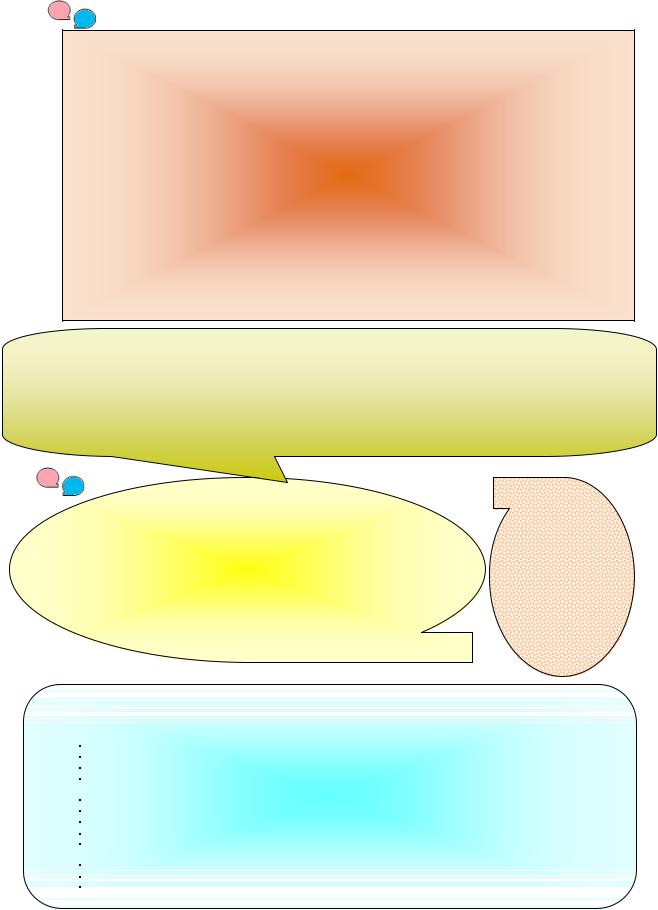
attachment/don't/any/is /a friend/it/safe/forward /being sure/without/to Don't forward any attachment to a friend without being sure it is safe.
you/place in/your /don't/if/ think/ have a virus/computer/backup floppy disks/ you
_____________________________________________________________________
have/any/you/are not sure/attachment/ if/you/ a virus/open/ scanner/don't/even/about/
_____________________________________________________________________
scanner/blasé/because/you/a virus /don't/just/have
_____________________________________________________________________
a "new virus"/without/an email/checking it / send out/ don't/about
_____________________________________________________________________
send/that/virus/to/other/official/virus/may/don't/mail/contain/anyone/ than/companies/a/
_____________________________________________________________________
12.Your colleague is a creative engineer at International Programmable Machines (IPM), which makes computers. He is responsible for currently problems which people face in everyday life using computer. Can you give him some advice to be done to solve problems? Don’t forget to visit website. Taking responsibility for one's actions is an important part of being an engineer.
http://www.youtube.com/watch?v=r5yGTtKQLco
You may start with:
–First of all the best way to improve safety is… .
–You’d (had ) better make a note of all the problems people currently face using computer.
–This needs to be your prime objective as an engineer.
–Then … .
–Finally … .
You may finish with:
So what are you waiting for? Start your own invention journey now! Good luck!
13. What do you think is the greatest technological innovation? Write an email to your colleague from London about it. Give your reasons. Use the phrases:
 Dear Mr. James, … .
Dear Mr. James, … .
 Thank you for your email of 8 February … .
Thank you for your email of 8 February … .
 I was very impressed … .
I was very impressed … .
 I would like to … .
I would like to … .
 Should you have any questions, please do not hesitate to contact me.
Should you have any questions, please do not hesitate to contact me.
 I look forward to hearing from you.
I look forward to hearing from you.
 Yours sincerely, … .
Yours sincerely, … .
41
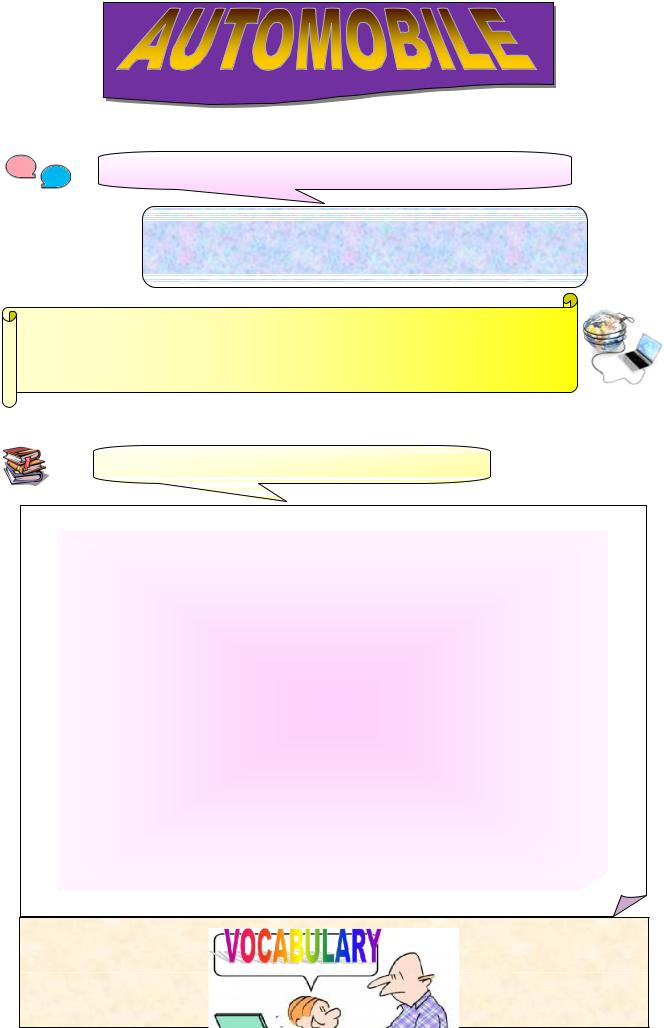
Lesson 5
1.Warm-up. In pairs or small groups discuss the questions.
Can you imagine our life without automobile? Why?
What kind of cars shall we have in future?
Would you like to go on a joy ride in Karl Benz’s "Velo" model?
2.Visit the website address given below. Describe the first car – Mercedes Benz.
http://www.youtube.com/watch?v=5YMG0EDffa
http://www.youtube.com/watch?v=lcObjfXzjl0&feature=relmfu
3. Read and translate the text into Russian.
Travelling by car at a high speed is an exciting experience. But how it all began? An automobile (via French from Greek auto, self and Latin mobilis moving, a vehicle1 that moves itself rather than being moved by another vehicle or animal) or motor car (usually shortened to just car) is a wheeled passenger vehicle that carries its own motor. Most definitions of the term specify that automobiles are designed to run primarily on roads, to have seating for one to eight people, to typically have four wheels2, and to be constructed principally for the transport of people rather than goods. However, the term is far from precise because there are many types of vehicles that do similar tasks.
One of the earliest sketches of a vehicle were made by Leonardo di ser Piero da Vinci (1452 – 1519), but one of the earliest attempts to propel a vehicle by mechanical power was suggested by Isaac Newton. Although Nicolas-Joseph Cugnot is often credited with building the first self-propelled mechanical vehicle or automobile. He built a steam-driven engine3 which had three wheels, carried two passengers and ran at maximum speed of four miles. In Russia Ivan Kulibin constructed a vehicle which had fly-wheel4, brakes5, gearbox6, thrust bearing7. François Isaac de Rivaz, a Swiss inventor, designed the first internal combustion8 engine which was fuelled by a mixture of hydrogen and oxygen and used it to develop the world's first vehicle to run on such an engine.
The first to perfect gasoline9 engine was N. Otto who introduced the four-stroke cycle of operation. But Karl Benz is generally acknowledged as the inventor of the modern automobile and Rudolf Diesel as a builder of the first Diesel Engine (1897).
The cars of that time were very small, two-seated cars with no roof, driven by an engine placed under the seat. Motorists had to carry large cans of fuel10 and separate spare tires, for there were no repair or filling stations to serve them.
42
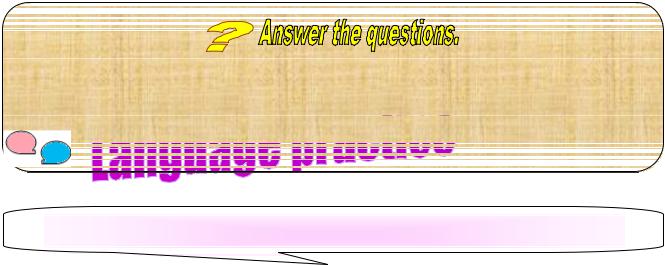
1. What does the word "vehicle" mean? 2. Who made the earliest sketches of a vehicle? 3. Who made the earliest attempts to propel a vehicle by mechanical power? 4. Why is Nicolas-Joseph Cugnot mentioned? 5. What kind of features did Kulibin’s vehicle have? 6. What mixture was the first internal combustion engine fuelled by? 7. What kind of engine did N. Otto use for the four-stroke cycle of 8. Who is generally acknowledged as the inventor of the modern automobile? 9. When was the
Engine built? 10. How can you describe the cars of that time?
1. Can you guess the meaning of these international words?
Compare your answers with a partner. Make a list of other similar words that you know.
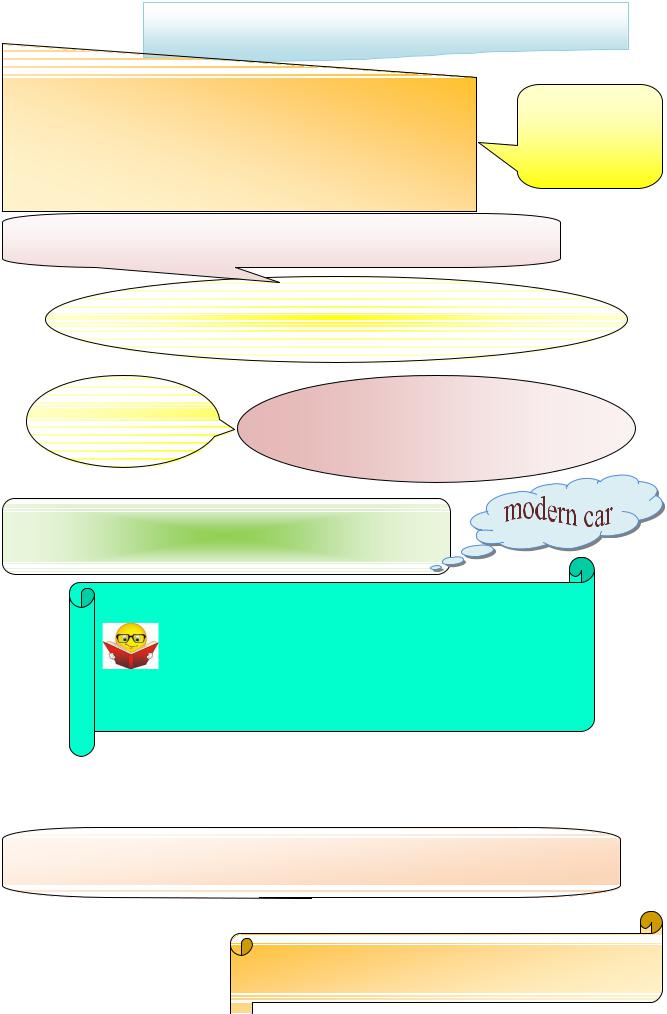
Automobile • motor • transport • mechanical • maximum • mile • construct • design • mixture • gasoline • cycle • operation • modern • diesel • motorist.
1.Первые чертежи автомобиля принадлежат Леонардо да Винчи.
2.И. Ньютон предложил транспортное средство привести в механическое движение.
3."Тележка Кюньо" приводилась в движение паровым двигателем.
4.Иван Кулибин сконструировал повозку, в которой применил маховое колесо, тормоз, коробку скоростей, подшипники качения.
3. Work in group. Have you ever driven these cars?
Take turns sharing your experience with other members of your group.
2. Translate
the following
sentences into
English.
Bus executive 4×4 jeep lorry luxury medium mini multi-purpose vehicle (MPV) people carrier pickup small family sports supermini truck van.
4. In pairs or small groups debate the following:
Transportation is a major contributor to air pollution in most industrialised nations.
Do you believe that one day stopping for petrol is likely to become a thing of the past?
Automobile propulsion technologies under development include gasoline/electric and plug-in hybrids, battery electric vehicles, hydrogen cars, biofuels and various alternative fuels. Add ideas of your own fuel?
Grammar tip |
|
|
|
Check |
|
|
|
|
The passive of a verb is formed by using to be in the |
||
|
appropriate tense and adding the past participle of the verb: |
||
|
For example: |
|
|
|
Active |
Passive |
|
|
|
She is doing it. |
It is being done (by her). |
|
|
She will do it. |
It will be done (by her). |
|
|
She did it. |
It was done (by her). |
|
For more on this, turn to ‘Grammar Reference’. |
||
|
|
|
|
5. Advertising plays an important role in promoting the features of car. Which features do you think are the most and least important for your car? Why? Take turns sharing your ideas with the other members of your group.
44 |
|
Advanced braking system (ABS) air condition |
airbag |
|
|||
|
|
alarm alloy wheels central locking climate control electric |
|
|
|
windows immobilizer (PAS) sunroof. |
|
|
|
|
|
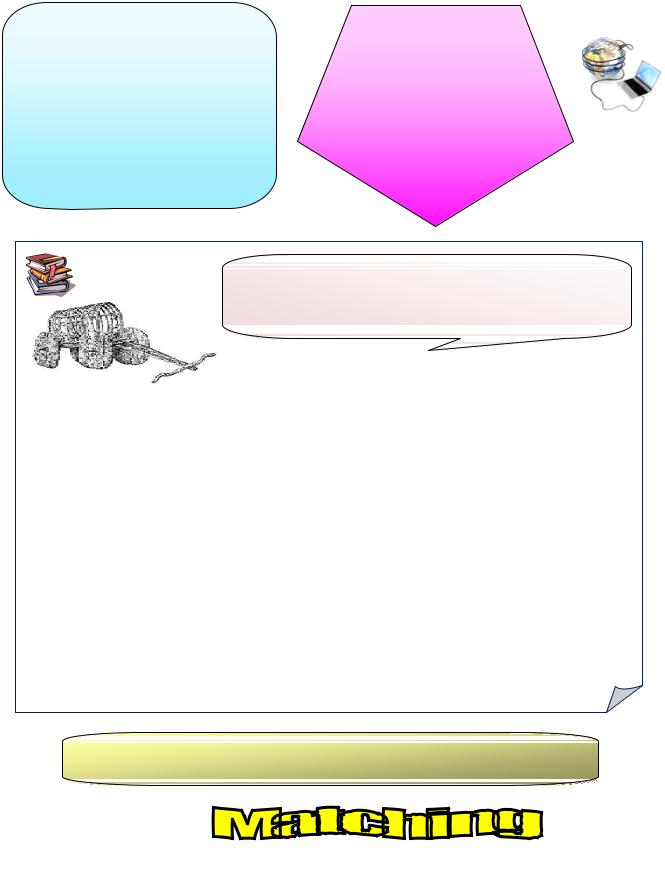
6.Visit the website address given below and watch the video.
MIT is working on a smart car that can reduce congestion on the highway and solve the many parking problems our country faces! To accomplish this, the car is designed to fold in half! Dean
Kamen shows us how.
http://planetgreen.discovery.com/videos/dea n-of-invention-car-that-folds-in-half.html
7. Read the text below and compose your own presentation of an ideal modern car. Discuss your presentations in class and decide whose idea of a modern car sounds more attractive.
Here is an article reviewing a modern car.
Put the verb in brackets into either Present Simple or
Present Simple passive.
Building a car ____ (take) a long time – from research, through design to final development. First, researchers need to determine what consumers ________ (want), and then suggest what kind of automobile to make. During the design phase, new ideas ________ (convert) into tangible parts or products. At the same time engineers _______ (modify) existing parts and features for the new model and draft new plans for the prototype (a working example of a new design). Then manufacturers _______ (begin) to construct a few prototypes. These ___ extensively ________ (test) in wind tunnels and dust tunnels, factory tracks, water-proofing bays, desert heat, arctic cold and crashes. At the next stage a plant _______ (set) up to build the new model and the necessary components. Product planners monitor the process to ensure that the new car programme _________
(finish) on time and within budget. Managers must also coordinate different activities, including producing the cars, purchasing materials, and training the workers.
This car must meet up-to-date requirements. What _____ (be) these features? The automobile must have high efficiency, long service life, driving safety, easy of handling and maintenance, exclusive appearance. Also it must ______ (be) rapid in acceleration, have smooth acting clutch, silent gearbox, dependable ignition system, low fuel consumption, comfortable and ecological.
Marketing teams must then sell the car. Every year the major car manufactures _______ (launch) their new models, but a single car design can take several years from the drawing board to the showroom floor.
8. Rewrite the sentences in an active into a passive if it is possible. Read them to your partner.
1. In pairs or small groups match the part of the car with its function.
45
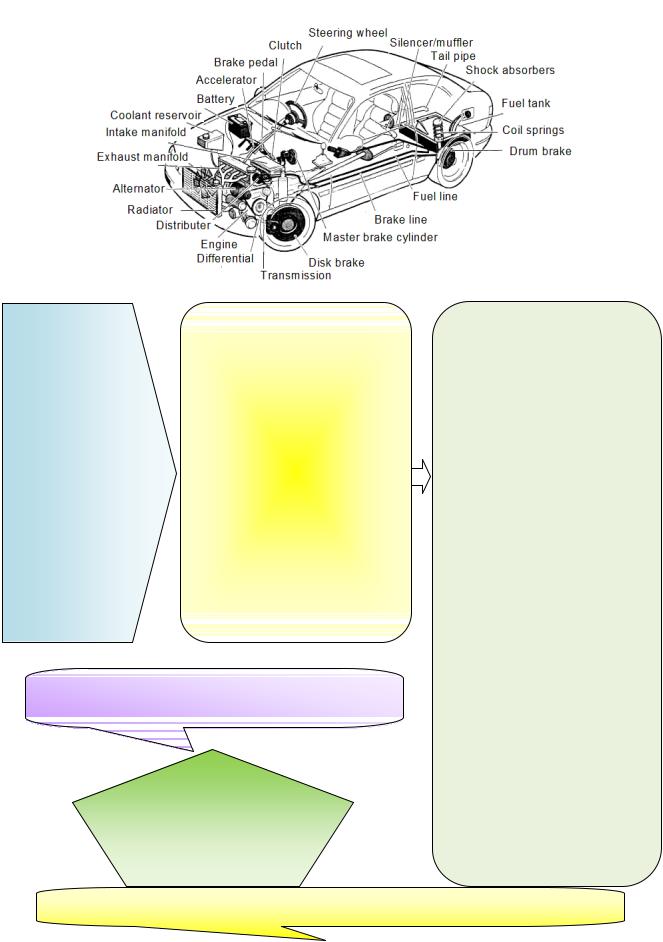
a) |
exhaust manifold |
a) |
глушитель |
|
b) |
steering wheel |
|||
b) |
выхлопной патрубок |
|||
c) |
radiator |
|||
c) |
рулевой механизм |
|||
d) |
fuel tank |
|||
d) |
генератор переменного тока |
|||
e) |
silencer/muffler |
|||
e) |
тормозная магистраль |
|||
f) |
battery |
|||
f) |
аккумулятор |
|||
g) |
brake line |
|||
g) |
топливный бак |
|||
h) |
differential |
|||
h) |
сцепление |
|||
i) |
clutch |
|||
i) |
двигатель |
|||
j) |
engine |
|||
j) |
тормозной цилиндр |
|||
k) |
accelerator |
|||
k) |
педаль газа |
|||
l) |
brake cylinder |
|||
l) |
распределитель зажигания |
|||
m) distributor |
||||
m)аккумулятор |
||||
n) |
alternator |
|||
n) |
дифференциал |
|||
|
|
|||
2. Make up a description of any system in a car. Let the students guess what it is.
Exhaust system Steering system Electrical system Coolant system Fuel system Brake system
1.a wheel turned by the driver of a motor vehicle when he wishes to change direction. It is connected to the front wheels.
2.a large container or reservoir for the storage of fuel.
3.carries waste gases to the exhaust pipe.
4.a device for cooling an internal-combustion engine
5.slows or stops car.
6.a device that reduces noise.
7.provides a source of electric current.
8.a device that connects or disconnects the engine to the gearbox.
9.enables the driving wheels to rotate at different speeds while turning the car.
10.converts energy (heat energy, into mechanical work).
11.holds brake fluid.
12.a pedal that makes a car go faster and controls the fuel intake in a vehicle.
13.in a petrol engine that distributes the high-tension. voltage to the sparking plugs in the sequence of the firing order.
14.an electrical machine that generates an alternating current.
3. Match the sentences on the left with the sentences on the right
|
|
|
|
|
1. |
Двигатель – это источник энергии. |
a) The main function of the gearbox is to change |
|
|
|
the speed of the car. |
46 |
|
|
|
2. |
Ходовая часть включает в себя раму с |
b) The running gear consists of a frame with |
|
|
осями, колёса и рессоры. |
axles, wheels and springs. |
|
|
3. |
Тормоза используются для остановки или |
c) The steering wheel is designed for changing |
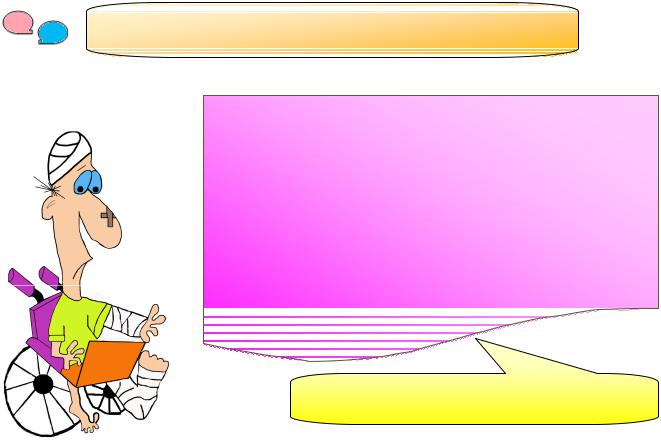
4. Find in the text English equivalents for the following:
Обратить в реальность модифицировать существующие детали разработать новый план сконструировать несколько аналогов аэродинамическая труба заводской трек водонепроницаемые отсеки аварийная ситуация отвечать современным требованиям долгий срок службы приемистость плавное сцепление бесшумная коробка передач малый расход топлива система зажигания кондиционер подушка безопасности аварийная сигнализация колесо из лёгкого сплава система запирания дверей с центральным управлением автоматическая система кондиционирования воздуха стекло двери с электрическим подъёмником иммобилайзер (блокиратор зажигания) "солярий".
5. Make up the sentences of your own with the words above in Passive.
47
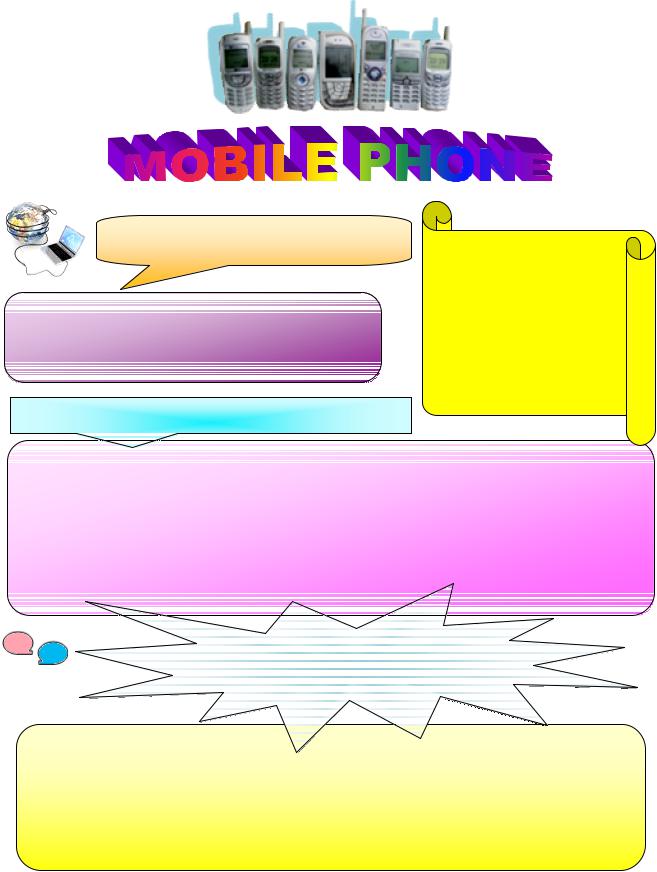
Lesson 6
1. Warm-up. In pairs or small groups discuss the questions.
Do you spend much time talking on the phone?
Does your mobile phone work in the mountains?
Are the mobile phones dangerous?
3.Guess the meaning of the words:
2. Visit the website address given below & watch the video. http://www.youtube.com/ watch?v=sJFK0tqO3Ik
Act out a conversation between Alexander Graham Bell & Thomas Watson.
Mobile • phone • electronic • communication • standard • function • telephone • service • SMS • email • Internet • MMS • photo • video • radio • category automatic • user • April • commerce • telegraph • Corporation • automatic • system • Europe • modern • technology • Radiolinja • Finland • decade • commerce • jacket • install • miniaturization • components • manufacture • group • practical • Nokia • Motorola • Samsung • Sony • Ericsson • LG • specific • region • Mitsubishi • Panasonic • Electric • Philips • Sanyo • Sharp • Siemens • Toshiba • million • active • Luxembourg • Hong Kong • population • Africa India • business • elite • culture • person • text • computer • etiquette • toilet • doctors • office • auditorium • Faraday • signal • distance • ignore • aeroplane • antenna • result • photograph
4. Create a short presentation of your mobile phone and things to be done to improve it.
There is
1.Get people's attention – Let's get started; Perhaps, we should begin?
2.Welcome them – Thank you for coming today; Good morning, ladies and gentlemen.
3.Introduce yourself – For those of you who don't know me, my name's … .
4.State the purpose of your presentation – This morning I'd like to present our new processor.
5.State how you want to deal with questions – There will be plenty of time for questions at the end.
48
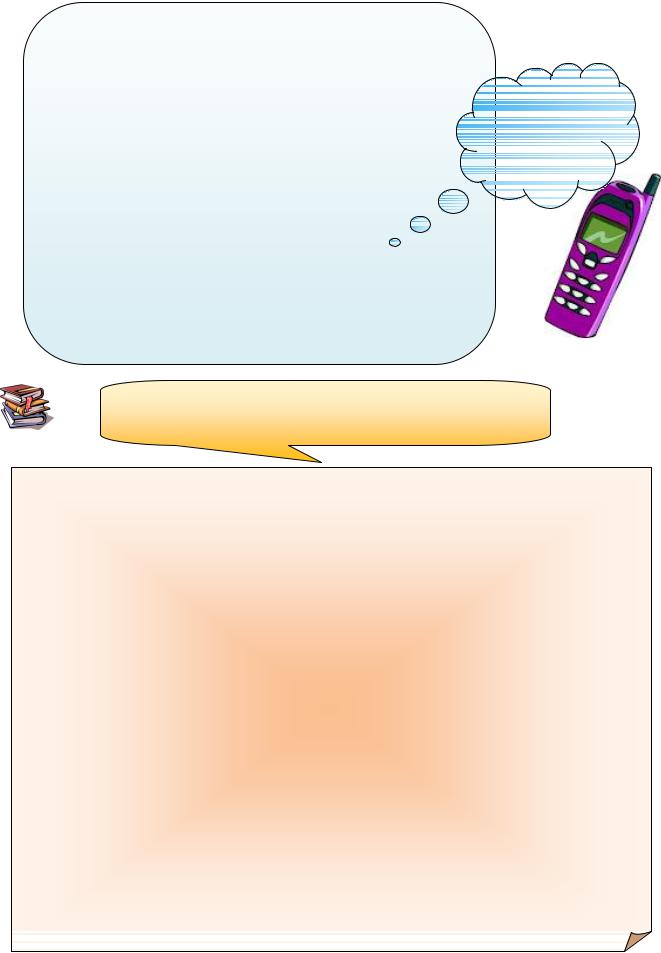
5.Short message service.
1.Write words that sound like these letters & numbers:
B C I Q R T U Y; 8 2 4 |
|
|
2. |
Write this text message in complete sentences. |
♥☺☺♥☺☺ |
|
R u coming 2night; |
|
|
PLZ; |
☺♥☺☺♥♥♫ |
|
B here b4 8 will w8; |
♥♫♫♫♥♫ |
|
c u l8er; |
|
Wen r u going 2 b here; |
|
|
|
How r u; |
|
I cnt believe u did dat; |
|
|
mt me 2moro nite @ 10; |
|
|
wld u mt me 2nite @ 8;
cld we chnge the mting 2 b4 lnch;
?4u;
cn i c u 2dy? thnx;
gt hr asap.
6.By skimming and scanning the text, you can increase your reading speed and find answers more efficiently.
The mobile phone or cellular1 phone is a long-range, portable electronic device used for mobile communication. In addition to the standard voice function of a telephone, current mobile phones can support many additional services such as SMS for text messaging, email, Bluetooth, packet switching for access to the Internet, and MMS for sending and receiving photos and video.
(1)____________Radiophones have a long and varied history. In 1945, the zero generation (0G) of mobile telephones was introduced. Due to their low establishment costs and rapid deployment, mobile phone networks have since spread rapidly throughout the world, outstripping2 the growth of fixed telephony. 0G mobile telephones, such as Mobile Telephone Service, were not officially categorized as mobile phones, since they did not support the automatic change of channel frequency during calls, which allows the user to move from one cell to another cell, a feature called "handover"3.
Motorola is widely considered to be the inventor of the first practical mobile phone for handheld4 use in a non-vehicle setting. Using a modern, if somewhat heavy portable handset, Motorola manager Martin Cooper made the first call on a handheld mobile phone on April 3, 1973.
The first commercial cellular network was launched in Japan by Nippon* Telegraph and Telephone Corporation (NTT) in 1979. Fully automatic cellular networks were first introduced in the early to mid 1980s (the 1G generation) with the Nordic** Mobile Telephone (NMT) system in 1981. This was followed by a boom in mobile telephone usage, particularly in Northern Europe.
The first "modern" network technology on digital 2G (second generation) cellular technology was launched by Radiolinja (now part of Elisa Group) in 1991 in Finland on the GSM standard. A decade later, the first commercial launch of 3G (Third Generation) was again in Japan by NTT on the WCDMA standard.
Until the early 1990s, most mobile phones were too large to be carried in a jacket pocket, so they were typically installed in vehicles as car phones. With the miniaturization of digital components, mobile phones have become increasingly handy over the years.
49

(2)__________ The mobile phone manufacturers can be grouped into two. The top five are available in practically all countries and comprise5 about 75% of all phones sold – Nokia, Motorola, Samsung, Sony Ericsson and LG. A second tier of small manufacturers exists with phones mostly sold only in specific regions or for niche markets – Apple Inc., Audiovox (now UT Starcom), Benefon, BenQSiemens, High Tech Computer Corporation (HTC), Fujitsu, Kyocera, LG Mobile, Mitsubishi, NEC, Neonode, Panasonic (Matsushita Electric), Pantech Curitel, Philips, Research In Motion, Sagem, Sanyo, Sharp, Siemens, Sierra Wireless, T&A Alcatel, Toshiba and Verizon.
(3)___________ Several countries, including the UK, now have more mobile phones than people. There are over five hundred million active mobile phone accounts in China, as of 2007. Luxembourg has the highest mobile phone penetration rate in the world, at 164% in December 2001. In Hong Kong the penetration rate reached 117% of the population in September 2004. The total number of mobile phone subscribers in the world was estimated at 2.14 billion in 2005. The subscriber count reached 3.7 billion by end of 2010 according to Informa.
Around 80% of the world's population enjoys mobile phone coverage as of 2006. This figure is expected to increase to 95% by the year 2011.
At present Africa has the largest growth rate of cellular subscribers in the world, its markets expanding nearly twice as fast as Asian markets. On a numerical basis, India is the largest growth market, adding about 6 million cell phones every month. With 156.31 million cell phones, market penetration in the country is still low at 17.45% India expects to reach 500 million subscribers by end of 2010.
In less than twenty years the mobile telephone has gone from being rare6, expensive equipment of the business elite to a pervasive, low-cost personal item. Given the high levels of societal mobile telephone service penetration, it is a key means for people to communicate with each other.
(4) ____________ The SMS feature spawned7 the "texting" culture. In December 1993, the first person-to-person SMS text message was transmitted in Finland. Currently, texting is the most widelyused data service.
Many telephones offer Instant Messenger services for simple, easy texting. Mobile phones have Internet service, offering text messaging via e-mail. In Europe 30 – 40 per cent of internet access is via mobile telephone. Most mobile internet access is much different from computer access and mobile internet access is hurried and short.
(5) ___________ Mobile telephone use etiquette is an important matter of social discourtesy, phones ringing during funerals, weddings, in toilets, cinemas and plays. Users often speak loudly, leading to book shops, libraries, bathrooms, cinemas, doctors'offices. Some new buildings, such as auditoriums, have installed wire mesh8 in the walls (making it a Faraday cage) which prevents signal penetration.
Trains, particularly those involving long-distance services, often offer a "quiet car" where phone use is prohibited, much like the designated9 non-smoking car in the past. However many users tend to ignore this as it is rarely enforced. Mobile phone use on aircraft is also prohibited and many airlines claim in their in-plane announcements that this prohibition is due to possible interference with aircraft radio communications. Shut-off mobile phones do not interfere with aircraft avionics. The nuisance10 of telephones on while aeroplanes take off and land, is that they disrupt the ground mobile telephone networks.
As customers want to be connected on planes, now several airlines are experimenting with base station and antenna systems installed to the aeroplane, allowing low power, short-range connection of any phones aboard to remain connected to the aircraft's base station. Thus, they would not attempt connection to the ground base stations as during take off and landing.
In a similar vein, signs are put up in UK petrol stations prohibiting the use of mobile phones, due to possible safety issues. Most schools in the United States have prohibited mobile phones in the classroom, due to the large number of class disruptions that result from their use, the potential for cheating via text messaging, and the possibility of photographing someone without consent. In the UK possession of a mobile phone in an examination can result in immediate disqualification from that subject or from all that student's subjects.
*Nippon – Ниппон – японское название Японии (Japan); **Nordic – нордический, скандинавский.
50
